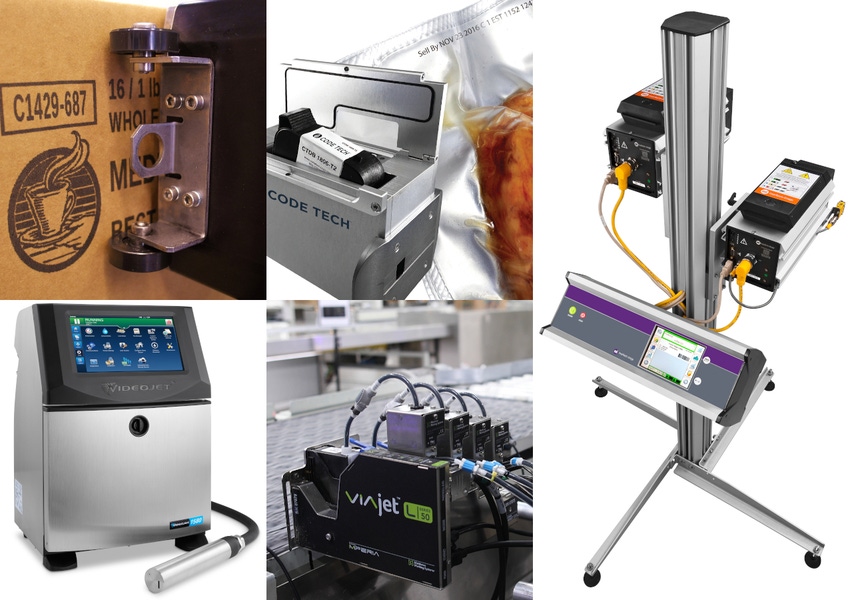
Inkjet technologies for primary-package coding and other small-character applications, as well as for large-character applications such as shipping-case coding, are advancing on several fronts, creating myriad benefits for brand owners and other packagers.
Advancements include enhanced interconnectivity and automation, smart systems, streamlined maintenance, remote service, improved inks, and greater ability to print on non-porous materials. Topping the list of benefits are greater productivity, reduced downtime and waste, lower costs, and higher-quality barcode printing — which in turn improves supply chain efficiency.
Packaging Digest’s exclusive Q&A on inkjet coders brings together, in our virtual space, six coding insiders sharing their insights on the many ways in which inkjet technology is evolving:
• Mark Breunig, regional product manager at Videojet
• Todd Cork, US sales and service director for Diagraph
• Raymond Fortuna, global product manager at Matthews Marking Systems
• David Holliday, director of product marketing at ProMach Labeling & Coding
• Greg Kasprzak, senior product marketing manager, large-character inkjet printers, at Markem-Imaje
• Michael Poulsen, large-character inkjet product manager for Diagraph
What recent advancements have you seen in inkjet coding equipment (either small- or large-character systems, or both)?
Kasprzak: In the area of large-character, high-resolution piezo inkjet systems, we are seeing better case-barcode printing, improving traceability and efficiency throughout the supply chain at reduced costs vs. labels. These systems also provide increased interconnectivity and automation to optimize production.
Rising manufacturer interest in using more sophisticated, data-packed barcodes, such as GS1-128, to improve traceability and facilitate automation throughout the supply chain is driving demand for improved barcode quality on product cases. High-quality, compliant barcodes enable more reliable scanning throughout the supply chain.
Printing and applying such barcodes onto cases via labels can be three times more expensive than printing barcodes and other information directly onto cases. However, not all direct-printing options can reliably achieve the necessary quality. The contrast and line-edge quality of directly printed barcodes needs to be high.
Advancements in inks and printhead management for large-character, high-resolution piezo inkjet systems enable customers to achieve this improved barcode quality.
Cork: We continue to see small-character inkjet manufacturers focus on ease of use and maintenance. All systems require maintenance to ensure proper operation and often require skilled labor and significant downtime to complete. But today, several systems have implemented a “service module” design to simplify scheduled preventative maintenance.
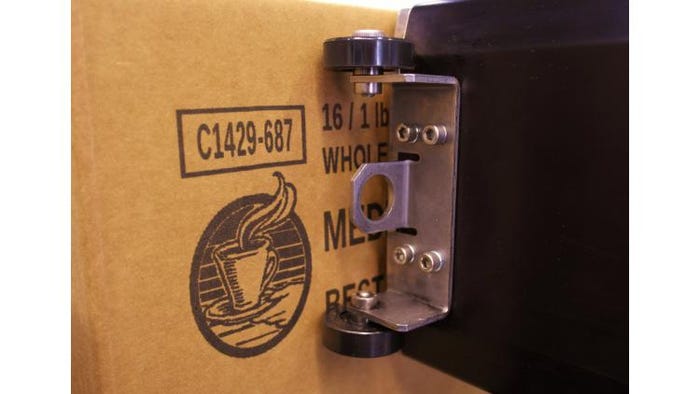
Diagraph’s IJ4000 high-resolution inkjet system uses piezoelectric (Trident Impulse Jet) technology and centralized ink delivery for multiple printheads.
Fortuna: Small-character bulk ink systems for thermal inkjet (TIJ) — Active Bulk Ink Systems (ABIS) — represent an important recent advancement in inkjet technology. I believe we are entering the age of “smart bulk ink.”
Holliday: The area of inkjet coding where we are seeing rapid advancements is with thermal inkjet — largely driven by HP.
HP introduced its thermal inkjet (TIJ) 2.5 system and its associated 45A ink cartridge a few years ago, and this created the platform for the development that has taken place since.
With the launch of TIJ 2.5, thermal inkjet technology was able to move out of the office and into serious industrial and packaging applications.
Breunig: With more intuitive user interfaces and remote connectivity, continuous inkjet (CIJ) printers are getting easier to use and maintain while overall operational costs, or total cost of ownership (TCO), continues to decline.
Solutions that take advantage of cloud connectivity, printer data, and remote-access technology are driving coding operations forward. Our remote-service solution gives CIJ-printer users, supervisors, and our technicians visibility to printer activity and the expertise to help keep printers up and running. Our technicians can remotely monitor printer status, as well as diagnose and troubleshoot any issues, without needing to be in front of the printer.
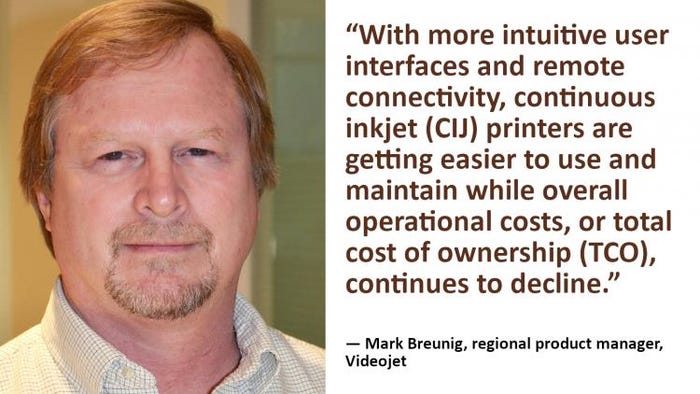
Poulsen: Auto-cleaning printheads for high-resolution inkjet coders are an absolute must in today’s production environments. Especially since most manufacturers are leveraging cost benefits of recycled corrugate, which simply creates a dustier environment than virgin corrugate cartons.
Across the industry, we are seeing increased interest in central control of automated inkjet-coding and -labeling systems.
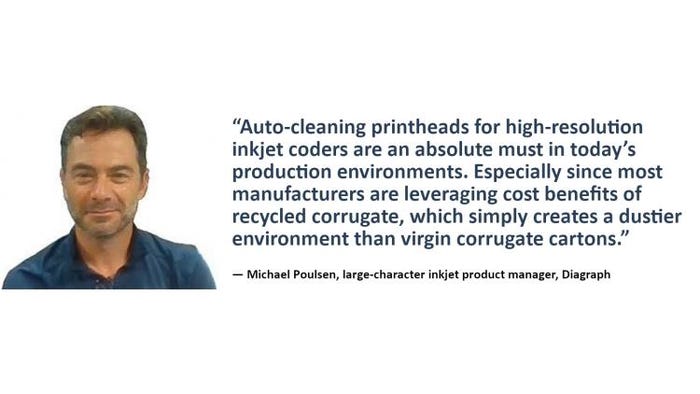
How do these advanced systems compare to previous systems?
Cork: Legacy coders required skilled labor for basic, preventative maintenance. Most required service in intervals as short as 2,000 to 4,000 hours of runtime. The maintenance procedure was invasive, and many companies would require the vendor to perform the service at a significant cost. It also introduced scheduling issues related to service availability and production downtime.
Most legacy systems, and many current systems, only offer a point-of-use interface. Some even require an interface per printhead. This leads to significant setup time, introduces accessibility issues, results in operator entry errors, and doesn’t allow for data validation across package types. Furthermore, many systems don’t even offer interface options, and message setup at the production line isn’t practical in many cases.
Previous systems didn’t offer any auto-cleaning options. Significant manual intervention was a requirement to maintain optimal print performance.
Kasprzak: “Old” inkjet systems are, and have historically been, used mainly for alphanumeric text and logos, and if for barcodes, then only for applications in which the barcode grade did not matter.
Traditional liquid inks tend to migrate into and along case corrugate fibers. It is, therefore, difficult to consistently achieve the minimum C grade required by GS1-128 barcodes, for example — even with the latest ISO/IEC 15416 (2016) standard.
By contrast, later-generation solid inks used in some high-resolution piezo inkjet coders, which melt and dry immediately on contact, ensure the final output is to the required standard, because that ink stays exactly where applied.
Modern large-character, high-resolution piezo inkjet coders can be linked to other systems to monitor and maintain standards. For example, vision systems can detect whether jets are clogged, triggering an automatic purge to restore print quality.
Holliday: For thermal inkjet, perhaps the most important improvement over previous systems is that the new cartridge technology has enabled the development of solvent-based inks, which include pigmented inks.
Previously, thermal inkjet was restricted to aqueous-based, or water-based, inks that were only suitable for use on porous materials.
These new inks have dramatically increased the number of applications for thermal inkjet to include printing of foils, films, and coated labels.
The chemistry behind the new inks continues to get better, with improved dry times; cartridge decap times, which is the time a cartridge can be left uncovered before ink dries in the nozzles; adhesion; contrast; shelf life; and even throw distance — traditionally, a thermal inkjet head needed to be mounted very closely to the substrate. There is a lot of ink development taking place, with new formulations arriving regularly.
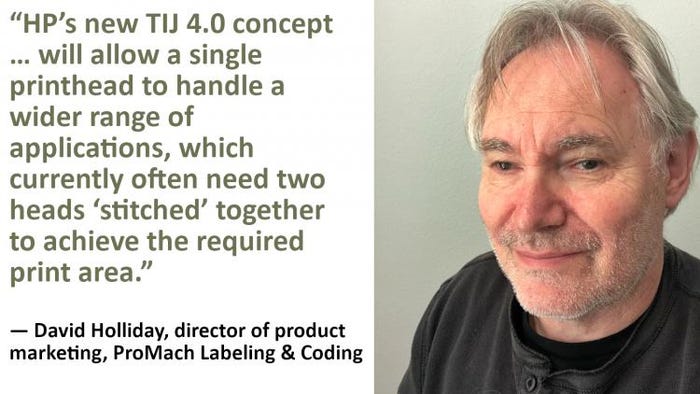
Fortuna: Smart bulk ink systems use processors and sensors to ensure accurate behavior even in shifting production environments. Former bulk units required adjustment as atmospheric conditions — pressure/temperature — changed. Smart systems provide a communication/feedback loop to the controller to allow for adjustments to be handled by software.

Breunig: Other systems have various maintenance items requiring multiple touches with different replacement schedules, but a single-component [system] is inexpensive and easy to change. Some units may have single components that last a long time, but they tend to be time-consuming and costly to replace.
What are the benefits of these advancements for packaging machinery buyers/users?
Poulsen: Today’s more advanced systems can offer powerful connectivity features to optimize changeover efficiency and eliminate coding/labeling errors and product holds. Printer-management software allows operators to drive product-identification solutions from primary product to pallet through intuitive product selection. It even offers the ability to drive changeovers from an approved mobile device.
Kasprzak: By printing higher-quality barcodes on cases, large-character, high-resolution piezo inkjet systems improve traceability and supply-chain efficiency — at significantly less cost than barcoded labels.
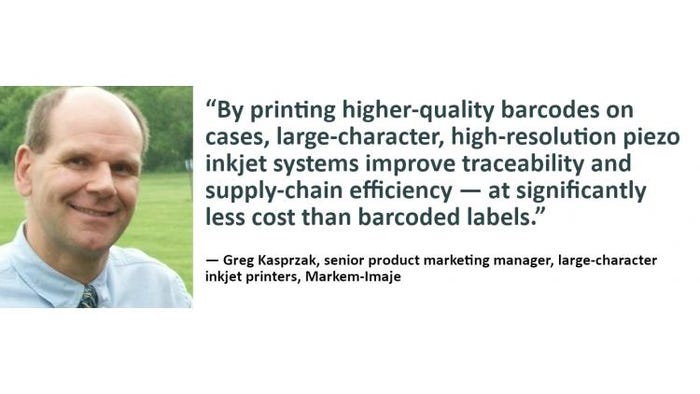
They also optimize production via increased interconnectivity and automation. Software to create and manage print jobs is getting more robust and is even able to monitor equipment availability to help drive improved efficiency on the packaging line.
Modern printers can be networked to other factory information systems and can use accessories such as scanners for automatic job lookup and cameras for code verification. They also support more secure and centralized management of the large number of codes, prints, or labels from which operators can choose.
With scanners and cameras, as well as links to back-office systems, if desired, less of an operator’s time is consumed selecting jobs and watching prints to make sure they are of a sufficient quality to ship. There is also greater accuracy. This all results in less downtime, rework, and scrap, as well as greater factory output.
Where modern printers have multiple input and output options, older systems are more standalone, with limited inputs and outputs. This has historically restricted their ability to be controlled centrally and made them unable to receive variable data from master work orders, enterprise resource planning (ERP) systems, or other databases.
Breunig: Although increasing production speeds is important, the largest opportunities for most industrial operations are efficiency and uptime. Reliable systems that continue to optimize their own performance and are supported by a strong service organization — yet are simple enough for customers to be self-sufficient with little effort — create an environment for improvement.
Cork: Today’s systems offer a longer-lasting module that can be replaced with non-skilled labor. We have one, for example, that offers an easy-change module with six times the life of previous models. The system steps an operator through replacement, which requires little intervention and can be done at the production line in less than 20 minutes to minimize interruptions to production.
Auto-cleaning printheads in high-resolution inkjet coders offer a much more reliable system and more consistent print quality. The key is a system that actually flushes the nozzle itself vs. spraying another solution over the surface, as most of the clogging issues with inkjet happen inside the head, not on the surface. Systems should not only flush/clean the critical components but manage waste collection, as well.
Fortuna: More reliable performance means more uptime and a significantly reduced cost per mark. TIJ solutions can be expensive in heavy-use environments. Bulk ink systems for TIJ bring cost of ownership more in line with CIJ, but with a higher-resolution mark.
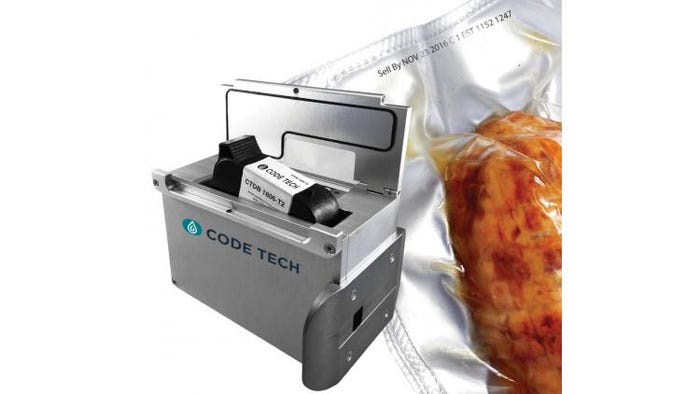
The Code Tech X1 Jet Washdown thermal inkjet printer from ProMach Labeling & Coding is primarily used in the protein industry and other markets in which equipment is washed down at the end of the shift.
Holliday: There are several benefits to the advancements of TIJ cartridges and inks. First and foremost, users can now print on non-porous products. Adhesion has improved greatly for durability on plastics, glass, metal, and other typically difficult substrates.
Ink advancement with pigments allows for printing on dark substrates using white or yellow inks, producing vivid results. The overall performance of the cartridge in terms of not drying out and being shelf stable for longer helps make this an excellent primary product-coding solution that has not typically been used in the past.
When comparing thermal inkjet technology with traditional continuous inkjet printers, the main differences are fast and easy installs; improved print quality, including the ability to print high-density 2D barcodes; exceptional ease of use; and minimal need for maintenance.
Thermal inkjet is also a great solution for companies wishing to minimize their use of harmful methyl ethyl ketone (MEK) and other solvents. And the development of harsh-environment printers makes thermal inkjet a viable technology for industries such as meat/poultry packaging, where conditions are tough and equipment needs to be washed down.
In addition to the other advantages, the capital cost is often much less than competing technologies.
What areas in inkjet coding still need work and why?
Poulsen: Manufacturers need to minimize components and cabling to simplify installation, minimize footprint, reduce the need for cabling, and offer more interface options. There is no reason why operators shouldn’t be able to use a password-enabled smartphone to drive message selection with a few keystrokes to stay up to speed with today’s fast-paced packaging environments.
Holliday: Areas with thermal inkjet that are still evolving include the need for faster-drying inks combined with better adhesion. Thermal inkjet inks currently cannot perform as well as some CIJ ink products, when it comes to these factors.
Another factor that TIJ can struggle with is the limited throw distance of the ink drops, which means that the printhead must be mounted very close to the product being coded. CIJ inkjet printers are a lot more capable in this area.
Fortuna: TIJ technology still needs to be very close to the substrate. This limits the acceptable applications. Round products or production lines with poor product control can struggle with maintaining the very short throw distance.
Kasprzak: With regard to large-character, high-resolution piezo inkjet systems, there is still scope for continued innovation to improve efficiency by increasing printer availability and reducing waste even further. Increased availability will likely come from continuing to reduce maintenance needs, improved networking with greater flexibility of input/output options, and support of standards-based integration.
Standards-based open protocols will be needed to be implemented as we move toward Industry 4.0 and the Industrial Internet-of-Things (IIOT), to enable interoperability of different equipment. Standards such as PackML are already in use to consistently model machine states and, in the future, I would expect to see more use of open protocols to securely manage transitions between those states, whether real-time or not.
Cork: Large-character inkjet needs to work towards a cost-effective solution for printhead replacement. Although inkjet systems are modular nowadays, printhead replacement can be costly. Most manufacturers only offer throwaway heads with a limited life. A repairable print-engine design enables exchange programs to help maximize uptime and minimize costs.
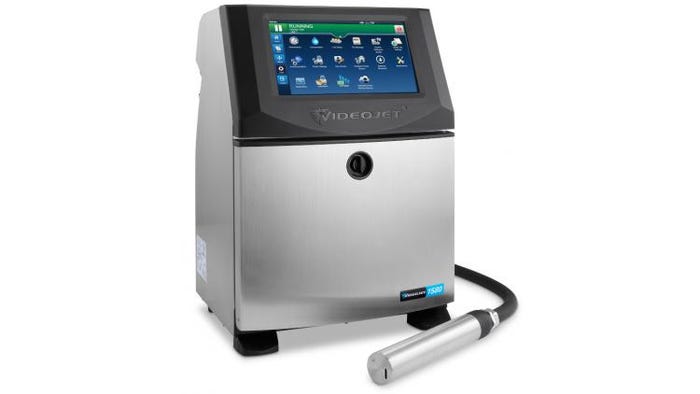
The Videojet 1580 CIJ printer’s interface features ease of use and flexibility for printing codes and text on products and packaged goods. The printer’s preventive-maintenance components are all in one module, for quick, easy replacement.
Breunig: Users often miss opportunities for improvement beyond the printer. Software solutions developed for a specific printer product line or brand can help improve production by taking advantage of predictive capabilities and analytics within the coding solution. Software solutions can also help users manage and monitor their production data, runtime, and stoppages.
CLICK NEXT BELOW: What’s next, and when might we see further improvements in inkjet coders?
What’s next, and when might we see further improvements in inkjet coders?
Holliday: There are several exciting new developments in thermal inkjet technology that we will see soon.
An important one is HP’s new TIJ 4.0 concept. TIJ 4.0 brings a print height of 22 mm (about 7/8 in.) compared to the current TIJ 2.5 maximum print height of 12.5 mm (1/2 in.). This will allow a single printhead to handle a wider range of applications, which currently often need two heads “stitched” together to achieve the required print area.
TIJ 4.0 has already been launched, but it currently can only use aqueous inks. The ability to use solvent-based inks that will allow for use on many more substrates is due to arrive in the future.
An alternative thermal inkjet system is produced by Funai that also shows a lot of promise. The Funai system offers longer throw distance, allowing more flexibility for installations and the ability to print into recesses on products — and higher speeds than the HP system.
In addition to the hardware developments, we expect to see the continuation of rapid development of inks for thermal inkjet, providing ever increasing performance.
There’s a lot happening in the world of thermal inkjet.
Fortuna: In TIJ, I expect to see the ability to print high-resolution marks on round products and in long-throw-distance applications.
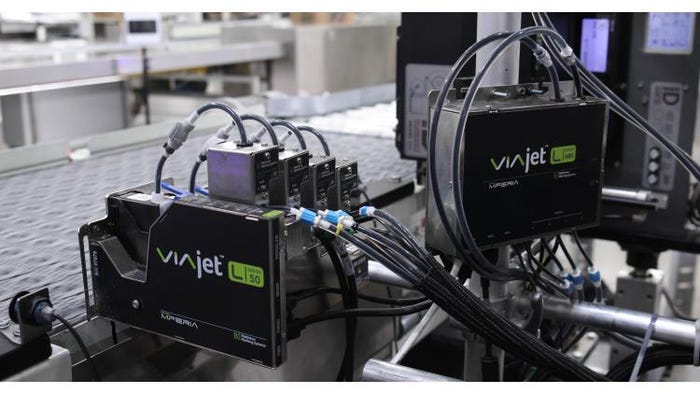
The VIAjet L-Series Active Bulk Ink System (ABIS) from Matthews Marking Systems provides high-resolution printing with water-based inks. The bulk system offers better productivity and lower cost than single-use cartridges.
Poulsen: A technology we plan to launch in 2020 will offer smart, wireless capabilities; minimize the number of necessary components; offer a number of different interface options to suit the customer’s specific requirements; and have an integrated, quick-change printhead for simple, on-the-fly changeovers.
A unique exchange program will allow the customer to exchange for a replacement quick-change printhead for a fraction of the cost of a new printhead, optimizing uptime and minimizing cost of ownership.
Kasprzak: Greater global interest in sustainability will lead to greater recyclability of consumables after printing, as well as recyclability of the packaging of those consumables. While Markem-Imaje already provides manufacturers with options to code more sustainably, much of the sector does not. For more information on our existing sustainability efforts, please see our comprehensive white paper. We predict that customer pressure will drive significant change in this area over the next five years.
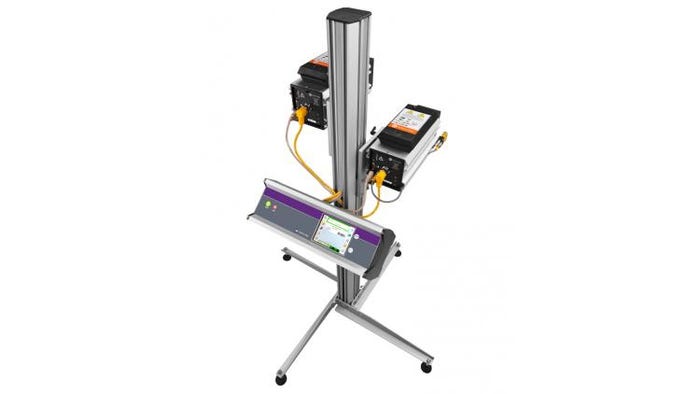
The Markem-Imaje 5800 large-character piezo inkjet coder prints high-resolution codes on corrugated cases, trays, and wrapping films, using environmentally friendly inks.
Breunig: We have been continually improving and expanding our inkjet-coder product line. Several new products are in the near-term pipeline and will be launched in 2020. We continue to enhance our software offerings and offer multiple options for purchase and financing. We’re also developing new ways to help decrease the time users spend maintaining printing devices, so they can focus on improving other areas of their operations.
About the Author(s)
You May Also Like




